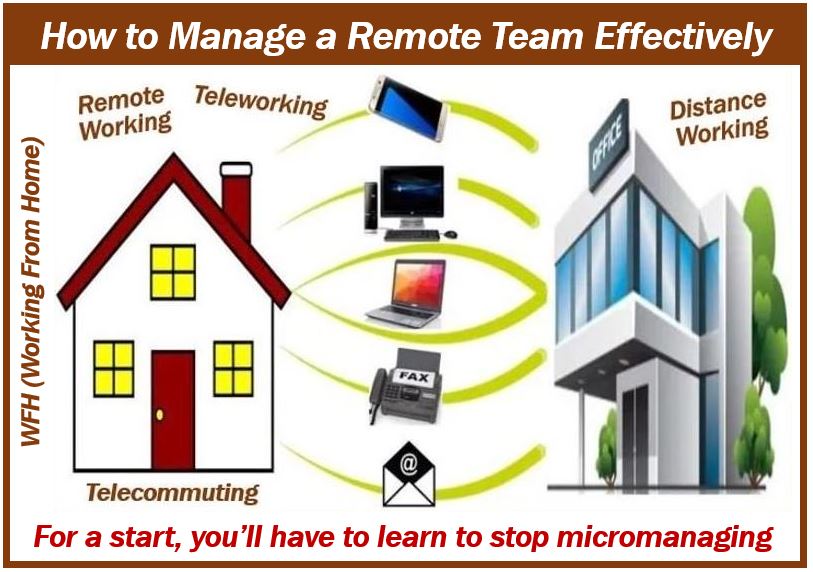The global lockdown caused by COVID-19 has caused legions of companies to shift from a headquarters-based working environment to a work-from-home setup. That shift has forced many CEOs and other executives to learn how to manage a remote workforce. That in turn has forced those same execs to ask themselves a vital question: How do I ensure my company’s success without micromanaging?

When it comes to leading a remote workforce, micromanaging your workers is a counterproductive approach for a wide variety of reasons.
First, it robs those workers of their sense of agency and autonomy. Daily nitpicking can lead to a loss of confidence, which in turn leads to a diminished desire to be creative and take smart risks. They’ll become scared to make mistakes and start to dread the start of a new workday.
Second, it’s an exhausting, overly taxing chore for you, the CEO. As head of your company, you’re responsible for running company operations, plotting strategy, overseeing sales, and numerous other essential tasks. If you start filling your day by looking over the shoulder of each and every one of your workers, you’ll burn out in a hurry.
Third, both you and your workers will come to resent the entire concept of remote work. Your employees will start to feel isolated and underappreciated. You’ll feel stressed and maybe even paranoid. All of the benefits of a remote work environment — from avoiding commutes to lower operating costs to eliminating the distractions of a crowded office — will get cancelled out by the mental and emotional strain caused by micromanaging.
Tips on avoiding macromanaging
Here are a few tips that you can use to avoid micromanaging, combat these potential problems, and manage a remote workforce in a healthy, supportive, and productive way.
Hire the right people

Sure, hiring the right people starts with finding workers who will do the job well. But the hiring process should go far beyond scouting for mere competence. Every company has its own culture, and it’s on you as a manager to preserve and nurture that company culture through remote onboarding. That means finding workers who fit the ethos that you want your company to have. For instance, if you want to foster a fun, laid-back environment, a highly competent worker who takes himself too seriously might be the wrong fit.
On the flip side, if you want to emphasize professionalism as your company’s guiding principle, a highly competent worker who’s always joking around might not make sense either.
These principles don’t only apply to the office; they’re highly relevant for remote work environments too. When you gather your workers for video conference meetings, there should be a sense of collaboration and mutual understanding, a sense that everyone is pulling from the same end of the rope. Without that vibe, your company culture could be in danger of eroding, which can cause problems that can be just as harmful as losing a big client.
Foster work flexibility
Since so many of us are being forced to work remotely anyway, we might as well make the best of the situation. Offices traditionally run on a fixed 9-to-5 schedule because that way everyone can keep tabs on everyone else.
With remote work, there’s an opportunity to rethink just about every aspect of the work experience. Maybe some of your employees are night owls who do their best work well after normal working hours have ended. Maybe others thrive by taking their laptop outside to work in the fresh air. As long as everyone’s getting the work done, the methods they use to do it shouldn’t be all that important.
Establish clear expectations
When your employees don’t do the work you want to see, it’s often because you haven’t given them a clear and attainable set of goals and targets. When both managers and workers have a mutual understanding of what the job entails, that makes it far easier for everyone to deliver on those expectations, and to ensure success without micromanaging.
Trust your employees
An extension of setting clear expectations, trusting your employees will empower them to become effective, independent, and reliable workers. If you manage a remote workforce with the trust that your employees are just as capable of doing a good job remotely as they do when they’re 10 feet away from you in the office, that will help both your peace of mind, and theirs.
Provide feedback
Consider this the follow-up phase that comes after expectation setting and establishing mutual trust. The only way for people to improve — in a work setting or anywhere else — is to first recognize where and how they’re falling short.
If you want to help your workers become more effective and more productive, providing constructive feedback that clearly outlines the areas in which they need to improve will go a long way toward making that happen. And of course feedback shouldn’t only be critical. Complimenting and thanking your workers for a job well done will reinforce their positive habits and encourage them to keep practicing them.
A good practice is running regular 1:1 feedback sessions. Before the actual meeting happens, ask your employee to fill out a self-evaluation form to reflect on their experiences, challenges, and career goals. Based on their input, prepare a constructive agenda that would combine both giving feedback, asking for it, and open discussion of relevant topics.
Encourage feedback from the other direction too
A healthy and thriving business isn’t a dictatorship. It’s an environment that encourages employees to speak openly and honestly about anything and everything. And it’s an environment that encourages managers to practice humility and self-reflection just as much as confidence and assertiveness.
Part of that process includes giving your employees the freedom to offer you constructive criticism too. No matter how mindful you might be of your own words and actions, you can’t fully know what kind of effect you’re having on your employees until and unless you provide them with a safe and comfortable environment that they can use to be candid even when it comes to your own management style.
By encouraging that kind of candor, your employees will feel more empowered and less concerned about ruffling feathers, and you’ll gain valuable insight into how you can improve too.
In short, if you want to manage a remote workforce effectively and ensure success without micromanaging, go the other way. Build a company that gives employees the confidence and the know-how to be self-starters and truth-tellers. Those skills will prove invaluable for years to come, whether your remote work environment lasts a few more months, or continues on long past the point at which the world has returned to normal.
Author Bio

Sharon Koifman is the CEO of DistantJob, a Montreal-based company that provides remote worker staffing and best practices-based advisory services for companies seeking to improve and expand their remote work operations.

